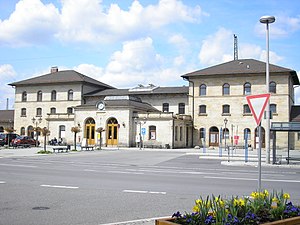Lichtenfels railway station
| Through station | |

East facade of the entrance building
|
|
| Location | Am Bahnhofsplatz 3, Lichtenfels, Bavaria Germany |
| Coordinates | 50°8′46″N 11°3′35″E / 50.14611°N 11.05972°ECoordinates: 50°8′46″N 11°3′35″E / 50.14611°N 11.05972°E |
| Line(s) | |
| Platforms | 6 |
| Construction | |
| Architect | Gottfried von Neureuther |
| Architectural style | Neo-Renaissance |
| Other information | |
| Station code | 3700 |
| DS100 code | NLF |
| IBNR | 8000228 |
| Category | 3 |
| Website | www.bahnhof.de |
| History | |
| Opened | 15 February 1846 |
Lichtenfels station is in the town of Lichtenfels in Upper Franconia in the German state of Bavaria. It is a regional rail hub and an ICE stop on the Hamburg–Berlin Munich route and is classified by Deutsche Bahn as a station of category 3.
Lichtenfels station is 31.9 km from Bamberg on the Bamberg–Hof railway and 150.9 from Eisenach on the Werra Railway at a height of 262.4 metres above sea level and is located west of the town centre and east of the Main river.
Planning of the Bamberg–Lichtenfels section of the Ludwig South-North Railway began in the summer of 1841, and work started shortly later. The line had to penetrate the town’s wall, which had to be rebuilt with a new Coburger Tor ("Coburg gate") over the line. The station, together with a depot, was first connected to the line in January 1846. The official opening ceremony followed on 15 February 1846. On 15 October 1846 the line was extended to Neuenmarkt and on 1 November 1848 the line reached its terminus in Hof. The first massive entrance building was a temporary wooden structure built between 1847 and 1850. In January 1859 the Werra Railway was extended to Lichtenfels, making the station a railway hub and requiring the upgrading of the station in 1862 to provide separate tracks for the Werra Railway Company and the Royal Bavarian State Railways. The station gained new significance with the opening of the Franconian Forest Railway to Probstzella in October 1885, part of a new long-distance route to Berlin. The acquisition of the assets of the Werra Railway by the Prussian government in the 1890s was followed by an extensive expansion and restructuring of the railway facilities. The number of running tracks was increased to eleven, with 17 signalman’s posts replaced by four signal boxes. Lichtenfels’ station area covered about 30 hectares and the railways employed about 29 percent of the city’s workforce in 1914. The Coburger Tor was demolished in 1889. In 1896 the Coburger Straße pedestrian bridge was built over the railway tracks; it was demolished in 1934.
...
Wikipedia
